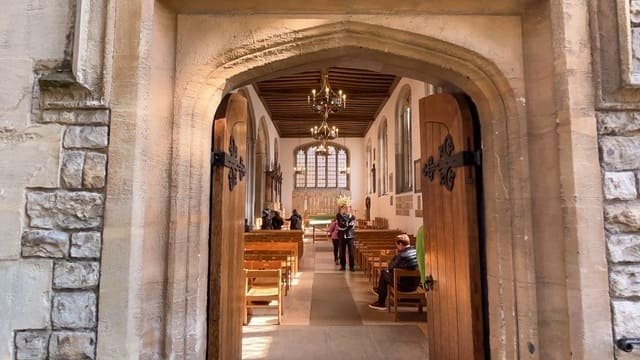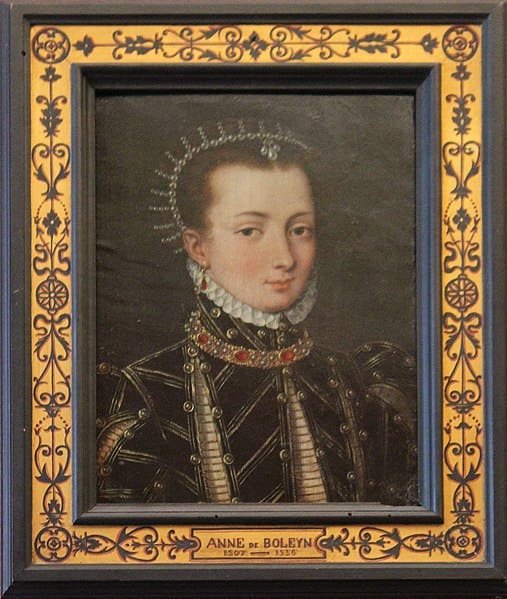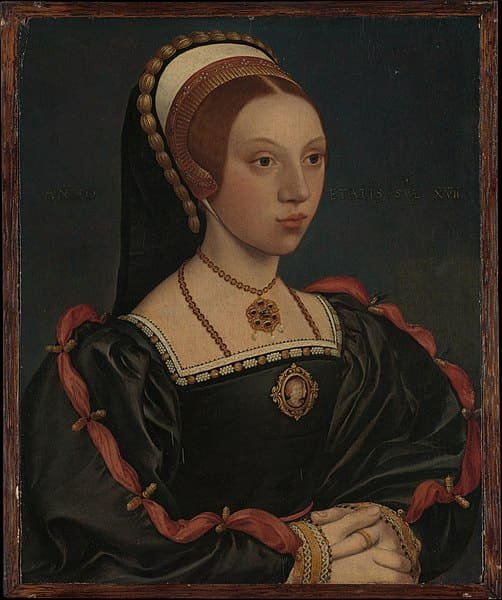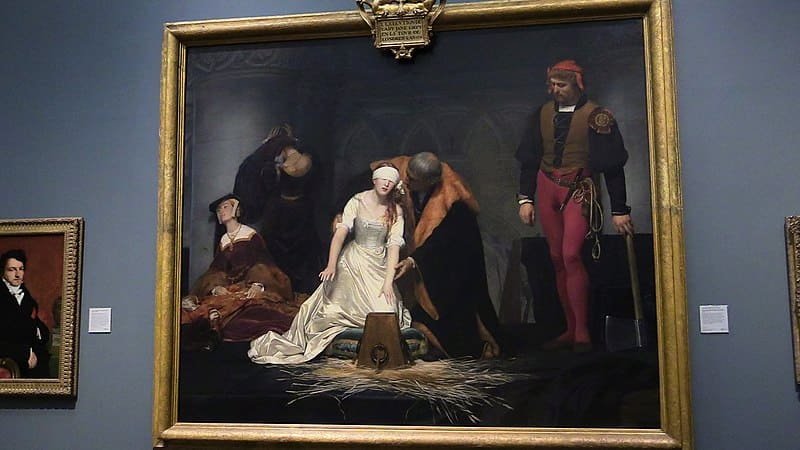
Audio Guide Script
Chapel Royal of St Peter ad Vincula you see before you was built between 1519 and 1520, but a place of worship has existed on this site since 1078. This Tudor-era building has witnessed some of the most pivotal moments in English history. The Latin name “St Peter ad Vincula” translates to “St Peter in Chains”, which is a direct reference to the biblical story of St. Peter being chained and imprisoned by King Herod Agrippa in Jerusalem.
Take a moment to admire the Spanish chestnut roof above you. It was specially constructed for Queen Katherine of Aragon, Henry VIII’s first wife, to remind her of her homeland. The decorative arches and some of the windows you see are original to the 16th-century construction.
As you walk through the nave, you’ll notice the tomb of Sir Richard Cholmondeley, the Lieutenant of the Tower who oversaw the chapel’s rebuilding. His final resting place occupies the center of this space.
The Chapel Royal of St Peter ad Vincula holds a unique place in history as the burial site of some of the Tower’s most famous prisoners. Among them are three Queens of England: Anne Boleyn, Catherine Howard, and Lady Jane Grey. Their stories, tragic and compelling, are intertwined with the very fabric of this building.
But this chapel is more than just a place of sorrow. For centuries, it has served as the parish church for the Tower of London community. Countless joyful events, including marriages and baptisms, have taken place within these walls, far outnumbering the somber occasions.
As we continue our tour, take note of the various architectural features. The piscina and hagioscope on the eastern wall are remnants of the chapel’s Catholic past, before Henry VIII’s break with Rome.
In more recent times, the chapel has undergone several changes. In 1951, the tomb of John Holland, Earl of Huntingdon and former Constable of the Tower, was moved here from another location. And in 2014, a full refurbishment was completed, with Her Majesty Queen Elizabeth II reopening the chapel later that year.
The Chapel Royal of St Peter ad Vincula stands as a testament to the enduring spirit of this ancient fortress. It continues to be an active place of worship, serving the Tower community just as it has done for five centuries.
As we conclude our visit, take a moment to reflect on the countless lives and stories that have passed through this sacred space. From royalty to commoners, from moments of great joy to times of profound sorrow, this chapel has borne witness to it all, standing as a silent guardian of history within the Tower of London.
About Anne Boleyn

Anne Boleyn was born around 1501, likely at Blickling Hall in Norfolk. She spent her formative years in France, where she developed a sophisticated charm and intellect that would later captivate the English court.
Upon her return to England in 1522, Anne quickly caught the eye of King Henry VIII. Their relationship would change the course of English history. Henry, desperate for a male heir and dissatisfied with his first wife Catherine of Aragon, pursued Anne relentlessly. Anne, however, was no ordinary courtier. She refused to become merely another royal mistress, insisting she would only be his wife and queen.
Their courtship lasted several years, during which Henry battled with the Catholic Church for an annulment from Catherine. When the Pope refused, Henry took the drastic step of breaking from Rome, establishing the Church of England with himself as the supreme head.
In January 1533, Henry and Anne married in secret. Later that year, she was crowned Queen of England in a lavish ceremony at Westminster Abbey. In September, she gave birth to a daughter, the future Queen Elizabeth I.
However, Anne’s inability to produce a male heir, combined with her outspoken nature and enemies at court, led to her downfall. In May 1536, she was arrested on trumped-up charges of treason, adultery, and incest. Despite maintaining her innocence, Anne was found guilty in a show trial and sentenced to death.
On May 19, 1536, Anne Boleyn was beheaded on the grounds of the Tower of London. In her final speech, she maintained her loyalty to Henry and asked the people to pray for him.
Anne Boleyn’s life was brief but extraordinarily impactful. Her relationship with Henry VIII sparked the English Reformation, forever changing the religious landscape of England. Her daughter Elizabeth would go on to become one of England’s greatest monarchs. Today, Anne Boleyn remains a figure of fascination, her story a testament to the power of ambition, the peril of royal favor, and the enduring impact of a life lived boldly.
About Catherine Howard

Catherine Howard was born around 1523, the daughter of Lord Edmund Howard and Joyce Culpeper. As a member of the powerful Howard family, she was a cousin to Anne Boleyn, Henry VIII’s second wife.
Catherine’s early life was marked by financial hardship. At a young age, she was sent to live with her step-grandmother, Agnes Tilney, the Duchess of Norfolk. In this household, supervision was lax, and it was here that Catherine’s troubled history began.
In 1539, at about 16 years old, Catherine caught the eye of King Henry VIII while serving as a lady-in-waiting to Anne of Cleves, Henry’s fourth wife. The king, nearly 50 and unhappy in his marriage, was immediately smitten with the young, vivacious Catherine.
Henry and Catherine married on July 28, 1540, just days after his marriage to Anne of Cleves was annulled. The king showered his new bride with gifts and affection, calling her his “rose without a thorn.” For a time, it seemed Catherine had brought joy back into Henry’s life.
However, Catherine’s past and present actions would soon lead to her downfall. Rumors of her infidelity began to circulate at court. It came to light that she had relationships before her marriage and was possibly continuing an affair with Thomas Culpeper, a courtier.
In November 1541, Catherine’s past was uncovered, and she was stripped of her title as queen. Despite her pleas for mercy, Henry was furious and heartbroken. He had Parliament pass an act making it treason for an unchaste woman to marry the king.
On February 13, 1542, Catherine Howard was executed at the Tower of London. She was likely only 18 or 19 years old. In her final moments, she reportedly asked for mercy for her family and declared that she deserved to die for her offenses against the king.
About Lady Jane Grey

Lady Jane Grey, often referred to as the “Nine Days’ Queen”, is a tragic figure in Tudor history whose brief reign left an indelible mark on England.
Lady Jane Grey was born in 1537, the great-granddaughter of King Henry VII. She was raised as a devout Protestant and received an exceptional education, becoming fluent in several languages including Latin, Greek, and Hebrew.
In 1553, at the age of 15, Jane found herself at the center of a political storm. King Edward VI, son of Henry VIII, was dying without an heir. Fearing the restoration of Catholicism under his half-sister Mary, Edward named Jane as his successor, bypassing both Mary and Elizabeth in the line of succession.
On July 10, 1553, following Edward’s death, Jane was proclaimed Queen of England. However, her reign was destined to be short-lived. The country rallied behind Mary, seeing her as the rightful heir to the throne. Just nine days after her coronation, on July 19, Jane was deposed, and Mary was proclaimed queen.
Jane’s fall from grace was swift and merciless. She and her husband, Lord Guildford Dudley, were imprisoned in the Tower of London and charged with high treason. Initially, Queen Mary showed mercy, sparing their lives. However, when Jane’s father participated in a rebellion against Mary’s planned marriage to Philip of Spain, Jane’s fate was sealed.
On February 12, 1554, at the age of 16 or 17, Lady Jane Grey was executed at the Tower of London. Witnesses reported that she faced her death with remarkable courage and dignity. Her last words, according to tradition, were, “Lord, into thy hands I commend my spirit.”
Lady Jane Grey’s brief life and reign serve as a poignant reminder of the turbulent nature of Tudor politics. She was a pawn in a dangerous game of power, manipulated by ambitious nobles and caught in the crossfire of religious conflict.
Now, let’s head back outside and walk around the lawn in front of us. As we go, you’ll notice an emerald-colored glass round table with a jade-like pillow-shaped sculpture on it. This is our next destination, the Execution Memorial. It should be easy to find as there will likely be a lot of people gathered around!
